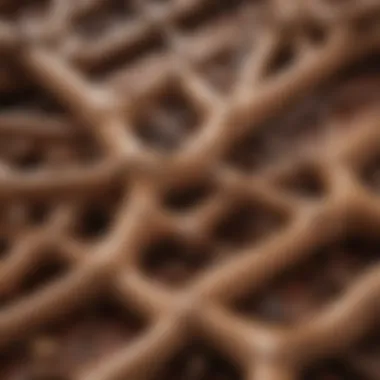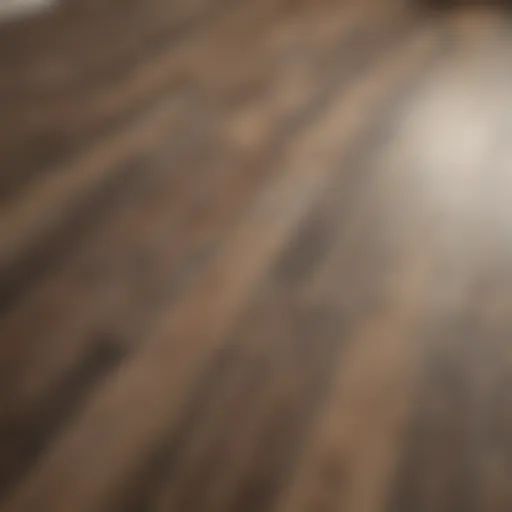Dynamics of Wood and Rubber Adhesives Explained


Overview of Topic
When it comes to home improvement, many homeowners don’t realize the intricacies involved in joining two different materials. Wood and rubber are common yet challenging materials that often need to be bonded for various projects, from crafting DIY furniture to repairing outdoor equipment. Understanding the dynamics of wood to rubber adhesives is crucial in ensuring a strong and durable bond.
The topic is particularly relevant for those venturing into home projects or repairs, as the right adhesive can save time, improve durability, and enhance the overall quality of the work. Wood is known for its natural aesthetics and structural strength, while rubber provides flexibility and resilience. However, finding an adhesive that can effectively bridge the properties of these two materials can often be a daunting task.
Importance of the Topic: Effective adhesion is not simply about mixing two materials; it’s about creating a lasting bond that withstands the test of time, environmental factors, and mechanical stresses. A good understanding of these adhesives can lead to substantial improvements in the functionality and longevity of your projects. With the right knowledge, tasks that might seem convoluted can become straightforward, turning potential headaches into achievements.
Common Challenges and Solutions
Homeowners frequently face a range of challenges when attempting to bond wood to rubber. One major issue is the incompatibility of materials. Wood has a porous nature, while rubber tends to be non-porous and oily, which can hinder adhesion. Understanding this characteristic is vital for selecting the correct adhesive.
Another common problem involves surface preparation. If either surface isn’t cleaned or primed properly, the adhesive may fail. Hence, it’s crucial to ensure surfaces are free of dust, grease, or moisture before application.
To tackle these challenges, here are some solutions:
- Choose the right adhesive: Look for products specifically designed for bonding wood to rubber to maximize effectiveness.
- Prepare surfaces thoroughly: Use sandpaper on wood to increase surface area and rub down rubber with a solvent to enhance adhesion.
- Test adhesion strength: Before committing to large applications, test a small area to ensure the bond holds.
Product Recommendations
In the market, there are several adhesives that stand out for bonding wood to rubber. Each product has unique features that cater to various needs:
- Gorilla Super Glue Gel:
- 3M Super Weatherstrip and Gasket Adhesive:
- Elmer’s E7500 Carpenter’s Wood Glue:
- Benefits: Strong initial tack, no clamping required, water-resistant.
- Features: Thick gel consistency makes it ideal for porous and non-porous surfaces while preventing mess.
- Benefits: Ideal for outdoor projects, can withstand temperature extremes, and resistant to moisture.
- Features: Creates a flexible bond that won’t crack under stress, perfect for rubber gaskets and seals.
- Benefits: Non-toxic, easy to clean, good for interior use.
- Features: Provides a strong bond on wood, making it suitable for projects requiring rubber overlays.
These products cater to different environments and bond requirements, ensuring a solution for nearly any project you have in mind.
Step-by-Step Guides
Embarking on a project to bond wood to rubber can seem challenging, but with a straightforward approach, anyone can achieve professional results. Here’s a step-by-step guide to help you along the way:
- Select Your Adhesive: Based on your project requirements, prioritize products designed for wood-rubber adhesion.
- Prepare Your Surfaces: Clean the rubber with a solvent. For wood, lightly sand the area to expose fresh fibers.
- Apply Adhesive: Apply the adhesive evenly onto one of the surfaces, following the manufacturer’s instructions for best results.
- Join the Materials: Press the wood and rubber together firmly for a few minutes to ensure initial bonding.
- Clamp or Weigh Down: If possible, use clamps or weights to hold the materials in place while the adhesive cures.
- Allow to Cure: Give the adhesive ample time to set according to the instructions. Patience is key to achieving the best bond.
- Finalize the Project: Once cured, inspect the bond and proceed with any additional finishing touches.
With these steps, even novice DIY enthusiasts can tackle their home improvement tasks with confidence and clarity.
Preface to Wood and Rubber Adhesives
When we talk about adhesives, the complexity often escapes casual understanding. Yet the relationship between wood and rubber through adhesive technology plays a significant role in a variety of applications that may surprise you. Understanding how these two materials interact through adhesive bonding techniques is not merely academic; it's pivotal for professionals like engineers, craftsmen, and even discerning house owners looking to optimize their DIY projects.
In this article, we aim to break down this intricate world. We'll cover everything from types of adhesives tailored for wood and rubber to how they function and the performance metrics that matter most. Knowing this can make or break your project. Choosing the right adhesive can boost the durability of household items, ensure safety in various applications, and extend the overall lifespan of your bonds.
Defining Adhesive Types
Different adhesives cater to different needs. At the heart of any project involving wood and rubber lies the selection of the correct adhesive type. Common varieties include:
- Polyurethane Adhesives: Renowned for their exceptional flexibility and bonding strength, they’re a go-to for wood-rubber applications.
- Epoxy Resins: These robust adhesives suit high-load applications where structural integrity is vital. They offer impressive strength, often standing the test of time and environmental conditions.
- Acrylic Adhesives: Noted for their fast-setting properties, they are useful for quick fixes or projects requiring immediate use.
Identifying these adhesive types and their specific characteristics gives an insight that helps in making informed choices based on project requirements. Each adhesive comes with its own set of advantages and limitations, essential to consider.
Importance in Industries
The significance of wood to rubber adhesives extends far beyond household applications. Industries such as automotive, construction, and furniture manufacturing rely heavily on these adhesive technologies.
- Automotive Industry: Car manufacturers use rubber and wood components for interiors and dashboards. Efficient bonding ensures durability and aesthetics, impacting both appearance and safety.
- Construction Sector: Adhesives are critical here, facilitating the creation of long-lasting structures. Wood to rubber joints offer flexibility and strength required for various applications.
- Furniture Production: In custom furniture making, understanding wood to rubber adhesives can lead to groundbreaking designs that marry functionality with form.
Overall, the knowledge of how to navigate the world of adhesives that bond wood and rubber not only enriches craftsmanship but also enhances overall structural integrity, making it a valuable focus for various professionals and job sectors.
"Choosing the correct adhesive type is crucial; it can define the performance and longevity of your work."
In exploring this subject, one can appreciate that the world of wood to rubber adhesives is both dynamic and essential. By understanding the interplay of chemicals, performance metrics, and successful application strategies, both professionals and amateurs can elevate their work to meet high standards. The path to harnessing these adhesives lays in insight and application, which this article intends to unravel.
Chemical Composition of Adhesives
Understanding the chemical composition of adhesives is crucial for any project involving wood and rubber. This section sheds light on what makes adhesives tick and the uniqueness of wood-rubber contexts. Knowing the composition not only helps in selecting the right adhesive but also in ensuring long-term performance.
Overview of Adhesive Chemistry
Adhesive chemistry revolves around the interactions between molecules that create a strong bond. At a basic level, adhesives work because they can form connections with both surfaces – wood and rubber in this case. The chemistry can involve various reactions, such as polymerization, where small molecules assemble into large chains, providing strength.
To understand the adhesive's performance, one must consider factors like:


- Viscosity: Determines how easily the adhesive can be applied. A lower viscosity means it's easier to spread, while a higher viscosity provides thicker coverage.
- Curing Agents: Certain adhesives require catalysts or hardeners to solidify properly. The choice of these can greatly affect the bonding quality and drying times.
- Testing for Compatibility: Not all adhesives will work well with both materials. For instance, polyurethane tends to work wonderfully for wood, but one must always check its compatibility with various rubber types.
Key Ingredients in Adhesives
Various ingredients come together in adhesives to ensure they perform effectively when joining wood to rubber. Some of the most significant components include:
- Polymer Resins: Form the backbone of most adhesives. Polyurethane and epoxy resins are popular due to their excellent bonding properties.
- Fillers: These materials can enhance the adherent’s physical properties. Common choices may include talc, calcium carbonate, or silica, all improving strength and durability.
- Plasticizers: These are often added to make the adhesive flexible once it dries. This flexibility is vital because both wood and rubber expand or contract due to humidity and temperature changes.
- Solvents: Many adhesives are formulated with solvents to make them easier to apply. However, it's key to be cautious here, as these can affect both health and environmental safety.
When selecting an adhesive, understanding each ingredient's role helps a lot. For example, you might find that certain fillers improve the toughness of a bond, while specific resins might enhance the adhesion itself.
Adhesion Mechanisms
Understanding the adhesion mechanisms between wood and rubber is crucial for anyone delving into adhesive technology. These mechanisms dictate how effectively an adhesive will bond materials, influencing the durability and performance of the final product. By grasping these concepts, house owners and DIY enthusiasts can make informed decisions when choosing adhesives for their projects.
Chemical Bonding Theories
Chemical bonding theories provide the foundational knowledge behind how adhesives function on a molecular level. When it comes to wood and rubber, it’s not just about sticking two surfaces together; it’s about how well those surfaces can interact at a molecular level. For instance, certain adhesives form covalent bonds, where atoms share electrons and create a strong connection. Polyurethane adhesives are an excellent example of this, as they can form robust linkages with both the wood fibers and rubber compounds.
On the other hand, ionic bonds and hydrogen bonds also play significant roles. Hydrogen bonding is particularly notable in water-based adhesives that contain polymers capable of interacting with the moisture in wood. This interaction can enhance adhesion but also may require careful consideration of wood moisture content during application.
In essence, understanding various chemical bonding theories equips users with the ability to select the right adhesive for specific materials and conditions.
Physical Interactions
Physical interactions, while less precise than chemical bonds, are often just as important in the adhesion equation. These include van der Waals forces and mechanical interlocking, both of which can contribute significantly to the overall strength of an adhesive joint.
When wood and rubber are bonded, their surface textures and chemical compositions can create favorable conditions for these physical interactions. For instance, if the rubber surface has a rough texture, the adhesive may physically lock into the crevices of both materials, enhancing the bond strength.
Moreover, the application technique can affect these physical interactions. Proper preparation methods like sanding or texturing can increase surface area and improve adhesion dramatically. This is where the synergy of both physical and chemical properties shines.
"A well-prepared surface can often be as crucial as the quality of the adhesive itself. It’s a dance between the two that determines the longevity of your bond."
Surface Preparation Techniques
Surface preparation techniques play an essential role in ensuring the effectiveness of wood to rubber adhesives. These steps, though often overlooked in casual discussions, can make or break the success of an adhesive bond. Proper preparation not only enhances adhesion but also elongates the lifespan of the bonded materials. Understanding the nuances of cleaning, priming, sanding, and texturing can pave the way for superior results, ultimately leading to more durable and functional products.
Cleaning and Priming
Cleaning and priming are critical first steps in surface preparation. Before applying any adhesive, it is paramount to remove any contaminants that may weaken the bond. Dust, grease, and moisture can act as barriers, interfering with the bonding process.
- Dust Removal: Employ a soft brush or compressed air to eliminate dust particles from the surfaces.
- Grease Elimination: Utilize solvents that are compatible with both rubber and wood. Common options include isopropyl alcohol or acetone—both of which can effectively cut through oily residues.
- Moisture Control: Ensure that the surfaces are completely dry. Adhesives often perform poorly if moisture is trapped beneath the surface. It may even be beneficial to use a moisture meter to gauge the wood's content.
Beyond cleaning, priming serves an additional purpose. A primer creates a uniform surface, enhancing the bond between wood and rubber. A specialized primer can penetrate wood fibers while providing a suitable surface for the rubber adherent. In many cases, this can increase the overall effectiveness of the adhesive by allowing better penetration into surface irregularities. It’s akin to preparing the canvas before painting; if the foundation isn’t set, the artwork won’t hold.
Sanding and Texturing
Sanding and texturing add another layer of preparation, significantly contributing to adhesive performance. By altering the surface characteristics of materials, these techniques can enhance mechanical interlocking, which is crucial for a strong bond.
- Sanding: When sanding wood, opt for grit that will smooth the surface without leaving it too polished. A medium grit, such as 120, followed by fine grit, around 220, often provides an optimal texture. This is similar to how a professional would prep a wall for painting—ensuring that the surface is neither too rough nor too slick allows adhesives to grasp more tenaciously.
- Texturing: In contrast to sanding, texturing can introduce microscopic features that further enhance the bond. For rubber, lightly abrading the surface can promote better adhesion. This technique creates tiny valleys and peaks that the adhesive can cling to, mimicking how Velcro operates—catching on to each protrusion for a stronger grip.
“Successful bonding starts before the adhesive is even applied. Preparation defines the limit of your adhesive's potential.”
To summarize, both cleaning and priming, alongside sanding and texturing, are vital components of surface preparation techniques. By prioritizing these steps, housewives and homeowners can ensure a successful and long-lasting bond between wood and rubber. Adhering to these practices not only amplifies the adhesive's effectiveness but also enhances the overall satisfaction of successful projects.
Types of Wood to Rubber Adhesives
Understanding the various types of wood to rubber adhesives is crucial for anyone looking to create durable and reliable bonds in their projects. Each type of adhesive comes with its own unique properties, benefits, and considerations. It's nearly impossible to overstate how critical it is to choose the right adhesive for a specific application, whether that be for furniture making, shoe repair, or crafting.
With a myriad of options available, knowing the characteristics of polyurethane, epoxy, and acrylic adhesives will not only empower you in making informed decisions, but it can also save time and reduce potential mishaps in your projects. The choice of adhesive plays a significant role in the effectiveness and longevity of the bond between wood and rubber.
Polyurethane Adhesives
Polyurethane adhesives are renowned for their exceptional flexibility and moisture resistance, making them an ideal choice for applications that involve varying environmental conditions. This type of adhesive forms a strong, durable bond between wood and rubber, effectively accommodating the natural expansion and contraction of materials due to temperature changes.
One of the key advantages of polyurethane adhesives is their versatility. They can be used on a range of substrates, which is particularly useful for housewives and homeowners engaged in DIY projects. Here are some essential points to consider:
- Water-resistant: Ideal for outdoor projects or areas exposed to humidity.
- Flexible: Accommodates movement without cracking.
- Strong bond: Can endure heavy stress, suitable for structural applications.
These properties not only enhance durability but also widen the scope of projects you can undertake.
Epoxy Resins
Epoxy resins are another top pick among professionals and DIY enthusiasts alike. Known for their incredible bonding strength, these adhesives are perfect for high-durability applications. When combined with hardeners, epoxy resins cure to create a solid, rigid bond, which is particularly advantageous when fixing or joining dissimilar materials, such as wood and rubber.
Some significant aspects of epoxy adhesives include:


- High tensile strength: Excellent for load-bearing applications.
- Resistant to chemicals: Protects against degradation from environmental factors.
- Versatile: Suitable for many materials beyond just wood and rubber.
While epoxy resins can require more careful handling and mixing than other adhesives, the resulting bond strength and longevity often justify the extra effort.
Acrylic Adhesives
Acrylic adhesives stand out for their fast curing times and excellent clarity. These adhesives create bonds that are solid and durable but maintain a level of flexibility that is beneficial for applications involving rubber. They offer good adhesion to wood without the lengthy cure times of some other options.
Key benefits of acrylic adhesives include:
- Fast-setting: Ideal for projects that require quick turnaround times.
- Good impact resistance: Holds up well under stress without breaking.
- UV stability: Suitable for outdoor projects where exposure to sunlight might be a concern.
In sum, acrylic adhesives provide a compelling option for many household and craft projects.
"Choosing the right adhesive can make the difference between a project that lasts and one that falls apart."
Ultimately, selecting the correct type of adhesive makes all the difference in ensuring both effectiveness and satisfaction with your project outcomes. By understanding the unique properties of polyurethane, epoxy, and acrylic adhesives, you can confidently tackle wood to rubber bonding tasks with the right tools at your disposal.
Application Techniques
The application techniques used in wood to rubber adhesives are critical for ensuring optimal bonding performance. Selecting the right method not only affects the adhesion strength but also impacts the overall quality and durability of the final product. Understanding how each technique works can help housewives and homeowners achieve the best results in their projects, ensuring their creations last as intended while maintaining visual appeal.
One-Part vs. Two-Part Systems
When it comes to adhesive options, one-part and two-part systems offer unique benefits and have their own applications depending on the task at hand.
One-Part Systems are typically ready to use straight out of the container. They often come as adhesives that cure when exposed to air or heat. A good example of this is hot glue. This convenience makes them an attractive option for quick repairs or projects, particularly in household settings where time may be of the essence.
Pros:
- Immediate usability and convenience
- Reduced mess and simpler cleanup
- Excellent for quick fixes or crafts
Cons:
- May have limited strength and durability
- Environmental conditions can affect bonding performance
- Generally less resistant to high stress
On the other hand, Two-Part Systems require a mixing process before application. These adhesives consist of a resin and a hardener that, when combined, chemically react to form a strong bond. Examples include epoxy resins and various polyurethane adhesives. This method is often better suited for more demanding applications involving wood and rubber combinations, such as in furniture making or garage repairs.
Pros:
- Stronger bonds suitable for heavier loads
- Excellent chemical resistance
- Greater longevity under stress
Cons:
- Requires preparation and measurement
- Mixing can introduce timing issues and compatibility challenges
- Potential for more significant mess during application
In summary, deciding between one-part and two-part systems is all about the requirements of the project at hand. If a simple quick fix suffices, one-part adhesives will often do the trick. However, for more significant, demanding projects, investing time in a two-part system can offer durability and strength that’s essential for long-term performance.
Use of Application Tools
The choice of application tools can profoundly influence the efficacy of wood to rubber adhesives. While it may be tempting to go for the first tool at hand or stick to what you already own, the right tool can greatly enhance adhesion outcomes.
Here are some common tools that homeowners can rely on:
- Brushes: Ideal for applying adhesives evenly across larger surfaces. They're particularly useful for thin, liquid adhesives and often help achieve a smooth finish without clumps.
- Rollers: Useful for spreading adhesive over a broad area, especially when working with large rubber sheets that need to bond to wood.
- Squeegees: Effective in ensuring that adhesive is evenly spread while removing any excess material, improving the bond and appearance.
- Caulking Guns: These are typically used for one-part adhesives in a cartridge form. They provide precision in application and make it easier to control the amount of adhesive dispensed.
- Mixing Sticks: For two-part adhesives, having the right mixing sticks helps ensure that components are blended adequately, which is crucial for achieving the necessary bonding strength.
In measure, utilizing the proper application tools and techniques can make all the difference between a successful project and one that disappoints. By equipping yourself with the right information and tools, you can ensure that each adhesive application yields the best possible results, allowing your creations to thrive.
Performance Metrics of Adhesives
Understanding the performance metrics of adhesives is crucial for anyone looking to bond wood to rubber successfully. These metrics ensure that the chosen adhesive meets or exceeds expectations in application. By analyzing factors such as shear strength and durability, one can make informed decisions that lead to better results. In sticking wood and rubber, characteristics may differ significantly according to specific applications, which makes it essential for homeowners and DIY-enthusiasts to comprehend these principles. Evaluating adhesives on these metrics can also lead to significant cost savings, reducing the need for frequent repairs or replacements.
Shear Strength Testing
Shear strength testing assesses an adhesive's ability to resist forces that could cause the glued materials to slide past each other. This testing mimics real-world conditions, where movements might occur due to temperature changes, humidity variations, or mechanical loads.
A higher shear strength indicates that the adhesive can hold the materials together under substantial stress without failing.
It's essential to measure this metric because if an adhesive can't withstand shear forces, everything else—the appearance, the ease of application—falls flat.
Key Points to Remember:
- Typically expressed in Pascals or pounds per square inch (psi).
- Helps determine the right adhesive for various projects, such as furniture or decorative pieces.
- A thorough sheer strength assessment can reveal potential weaknesses or areas for improvement in adhesive formulations.
Durability and Lifespan
To ensure that wood to rubber bonds are long-lasting, evaluating the durability and lifespan of an adhesive is vital. This metric not only examines how well the adhesive can resist environmental factors but also how it withstands mechanical wear over time. Different adhesives offer varying levels of durability based on their chemical composition and application methods.


For instance, polyurethane adhesives often have excellent water and UV resistance, making them suitable for outdoor uses. On the other hand, some acrylic adhesives may provide superior flexibility but potentially fall short in extreme temperatures.
Considerations for Durability:
- Environmental resistance: Can the adhesive handle moisture or temperature changes?
- Mechanical wear: Will repeated movements or vibrations wear it down?
- Aging: How does the adhesive hold up over years of use?
By focusing on these performance metrics, homeowners can choose the right adhesives for their specific needs, ensuring that their projects stand the test of time.
Choosing the right adhesive with adequate performance metrics can save not just time but also money in the long run.
Environmental Considerations
In any discussion about wood to rubber adhesives, it's crucial to acknowledge the environmental considerations that underpin their use and production. Not only do adhesives play a key role in the functionality of applications across various industries, but their life cycle also significantly impacts the environment. Understanding these factors assists professionals in making informed choices, elevating the dialogue surrounding eco-conscious adhesive solutions.
Sustainability in Adhesive Production
Sustainability is not just a trend; it’s a necessity in today’s climate-conscious landscape. The manufacturing of adhesives that bond wood to rubber can pose environmental risks, including the use of volatile organic compounds (VOCs) and non-renewable resources. Thus, manufacturers are increasingly moving towards more sustainable practices.
Adhering to sustainability principles involves several aspects:
- Raw Material Sourcing: Many companies now prioritize bio-based raw materials that stem from renewable sources. This shift reduces dependence on petrochemical-derived substances, lowering the carbon footprint associated with production.
- Energy Efficiency: Innovative production techniques have improved energy efficiency, minimizing waste and resource use. Manufacturers are exploring methods such as renewable energy sources, which benefit both the environment and their bottom line.
- Ecological Impact Assessments: Conducting thorough assessments helps determine the total ecological footprint of adhesive products. By evaluating every stage—from sourcing to disposal—companies can identify areas for improvement.
Investing in top-notch sustainability strategies not only meets regulatory standards but also engenders goodwill among eco-conscious consumers, enhancing brand loyalty.
Recycling and Disposal Methods
Understanding the end-of-life stage of adhesives is just as vital as their production. Improper disposal methods can lead to considerable environmental harm. Thus, establishing effective recycling and disposal methods is paramount.
- Recycling Programs: Some adhesive manufacturers have begun implementing take-back programs, allowing households and industries to return unused or leftover products for recycling. These programs can significantly divert waste from landfills, turning what could be hazardous materials into reusable resources.
- Composting Options: For adhesives that are derived from natural materials, composting is a feasible disposal method. Such biodegradable adhesives can break down in composting systems, contributing to soil enrichment rather than polluting it.
- Clear Disposal Guidelines: Providing consumers with clear information about how to properly dispose of or recycle adhesives fosters responsible behavior. Whether it’s through online platforms or on-product labeling, educating users ensures that these materials don't adversely affect the environment.
"In the realm of wood to rubber adhesives, a wise consumer is an eco-friendly consumer. By understanding the life cycle of these products, we can minimize our ecological impact and promote sustainable practices."
Understanding environmental considerations in adhesive production is vital, not just for compliance but also for the well-being of our planet. Households and industries alike are adopting a greener approach, ensuring that future adhesive innovations continue to harmonize with nature.
Regulatory Standards and Safety
Adhering to the guidelines surrounding regulatory standards and safety is not just a bureaucratic formality; it’s the bedrock upon which successful wood to rubber adhesive applications are built. Understanding and implementing these standards can make a significant difference in the longevity, efficacy, and safety of your projects. As we delve into this topic, it’s important to recognize the benefits and considerations that come with compliance in this realm.
Industry Compliance Requirements
When talking about industry compliance requirements, we’re looking at a framework that ensures adhesive products are not only effective but also safe for use in various applications. Different regions have established regulatory bodies such as the Environmental Protection Agency (EPA) in the United States, which take charge of overseeing materials to ensure they meet safety and environmental standards. These requirements cover aspects like:
- Ingredient disclosure: Manufacturers must clearly label the chemicals contained within their adhesive products.
- Emissions standards: This pertains to the amount of volatile organic compounds (VOCs) adhesives can emit, impacting indoor air quality and health.
- Performance testing: Adhering to specified tests ensures that the adhesives reliably perform under various conditions.
By meeting these compliance requirements, manufacturers signal their commitment to quality and safety, validating the trust consumers place in their products.
Health and Safety Regulations
Health and safety regulations are crucial for anyone working with adhesives, particularly those that bond wood to rubber. These regulations aim to protect both the person applying the adhesive and those who come into contact with the finished product. Some common regulations include:
- Personal Protective Equipment (PPE): Workers should wear gloves and masks to prevent exposure to potentially harmful fumes or chemicals.
- Ventilation requirements: Adequate airflow is essential, especially when using adhesives with strong solvents to mitigate inhaling harmful vapors.
- Storage guidelines: Proper storage conditions limit the risk of chemical spills, ensuring that adhesives remain stable and safe during their lifecycle.
"Always read and follow the safety data sheets (SDS) provided with adhesive products for safe handling and application instructions."
These measures not only protect individual workers but also contribute to a healthier working environment—critical for project success and peace of mind.
In essence, understanding and adhering to regulatory standards and safety regulations is indispensable when working with wood to rubber adhesives. It's not merely about compliance; it’s about driving standards that ensure safety, trust, and quality in the marketplace. By making such conscientious choices, both manufacturers and consumers can take a vital step towards sustainable and safe adhesive applications.
Future Trends in Adhesive Technology
As we stride into an era that champions sustainability and efficiency, the landscape of adhesive technologies is not standing still. In the context of wood to rubber adhesives, future trends promise not only to enhance bonding capabilities but also to align with broader environmental goals. Understanding these trends allows manufacturers, hobbyists, and home improvers alike to make informed decisions about adhesive usage.
Innovations in Material Science
The confluence of material science and adhesive technology is presenting novel options for bonding wood with rubber. One significant trend is the development of bio-based adhesives. These adhesives rely on renewable resources, reducing dependency on petroleum-based chemicals. This trend not only spurs environmental benefits but also caters to a growing market that values sustainable practices.
Additionally, researchers are focusing on nanotechnology to fine-tune adhesive properties. By incorporating nanoparticles into adhesive formulations, enhancements in bond strength, temperature resistance, and flexibility have the potential to dramatically improve performance.
- Key Innovations:
- Bio-based Adhesives: Leveraging materials from natural sources such as soy, starch, or cellulose.
- Nanoparticles: Improving adhesive effectiveness through enhanced chemical interactions.
These advancements bring us closer to realizing adhesives that not only bond more effectively but also contribute positively to our planet.
Research and Development Directions
Looking ahead, the research and development spectrum focuses on both improving existing formulas and exploring entirely new adhesion mechanisms. One area of growth is in smart adhesives — those that change properties in response to environmental conditions such as heat, humidity or even pressure. This adaptability could revolutionize how household items are assembled, repaired, or even disassembled.
- Emerging Focus Areas:
- Smart Adhesives: Adapting properties based on external factors.
- Bioengineering: Examining natural processes to inspire new adhesives.
Furthermore, industry collaborations are forging paths towards innovations tailored for niche applications. For example, developing specialized adhesives for eco-friendly furniture or specific rubber materials enhances product longevity while minimizing waste.
"Innovation is the compass steering the future of adhesive technology. Staying attuned to these trends is crucial for anyone involved in material production or use."







